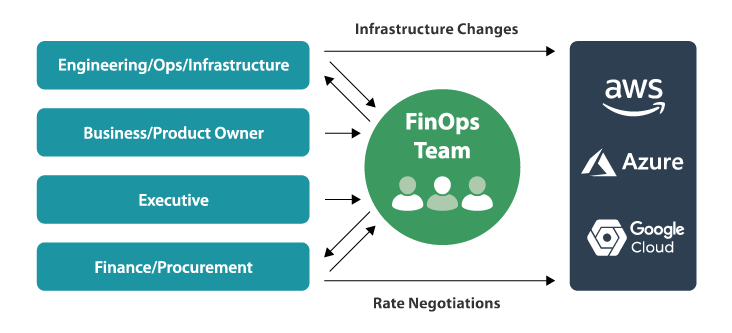Before cloud computing, finance departments were largely responsible for managing IT purchasing. The process was structured, carefully planned, and centrally controlled. Purchases occurred infrequently, and the cost of IT resources remained relatively fixed – as a clear capital expense, it was predictable.
Traditional CapEx IT purchasing, characterized by longer purchase cycles and a need for higher amounts of up-front capital, helps companies maintain crystal-clear visibility and control over all expenses.
Cloud computing simply doesn’t play by the same rules. Anyone with a credit card and email address can sign up for an Amazon Web Services (AWS) Account and spin up resources and services within minutes. In stark contrast to CapEx purchasing, buying cloud resources moves at the speed of work — often unplanned, frequent, and decentralized.
How can organizations in the cloud capture the versatility and potential of modern DevOps, yet still establish financial control over IT purchasing?
Enter Cloud Financial Management, aka FinOps
In the same way DevOps unites development and operations teams for streamlined application delivery, FinOps aims to optimize how teams build and buy in the cloud. FinOps is a collaborative practice and includes stakeholders from finance, technology, engineering, and business operations teams. With FinOps in place, companies can extract the most value from their cloud investments.

According to FinOps Foundation Principles, although “a centralized team drives FinOps,” not all decisions can or should be centralized. FinOps capabilities need to be balanced. But, what should you centralize and what should you decentralize?
Balancing Centralized and Decentralized FinOps Functions
The goal with FinOps is to maximize the value of our cloud investments. Value is maximized by efficiently acquiring (paying for) and efficiently consuming (using) resources. With that in mind, we believe the right balance can be achieved by following a simple precept first introduced by JR Storment in 2017:
“Decentralize using less (avoiding costs), centralize paying less (reducing costs).”
J.R. Storment
In other words, centralize price and rate management, but decentralize building and usage decisions to product and engineering teams.
Decentralize Utilization Decisions to Optimize the Use of Cloud
Engineers make better architectural decisions than finance people. This includes using the appropriate amount of cloud resources for each project. By decentralizing resource decisions to engineering teams, your engineers can build resource-efficient cloud environments from the start.
Systems and applications that meet engineering and end-user requirements can then be implemented without wasting cloud resources. This decentralized approach reduces potentially wasteful cloud resource usage and the associated costs.
Centralize Purchasing Decisions to Optimize the Cost of Cloud
Cloud discount instruments, like AWS Savings Plans and Reserved Instances, are often the biggest pricing levers you have to reduce your AWS bills. Centralizing the purchase and management of these cloud discount commitments can benefit your entire organization.
Here are three reasons to centrally purchase and manage AWS Savings Plans and Reserved Instances:
1. Centralized purchasing maximizes savings across the entire organizations
- Aligns incentives for the whole organization vs. individual teams or departments
- Allows for global vs. local optimization by looking at all savings opportunities
- Limits pricing and purchase decisions to those with the most expertise
2. Centralized purchasing minimizes the effort required to achieve optimal costs
- Reduces the need for communication among various purchasing teams
- Reduces overall effort with one team optimizing for all vs. many teams optimizing their own resources independently
- Shifts purchasing responsibility away from engineers, so they can focus on architecting and engineering
3. Centralized purchasing facilitates the creation of a Cost Center of Excellence
- Creating a central capability to purchase commitments, like AWS Savings Plans and Reserved Instances, and negotiate discounts like the AWS Enterprise Discount Program (and other cloud provider discount or credit programs) allows organizations to develop expertise in identifying all possible pricing efficiencies and taking maximum advantage of available discounts
- Centralizing cost optimization also ensures someone is responsible for solving cloud spend problems across the entire organization, instead of it falling to individual teams and potentially being neglected
Challenges to Centralized Commitment Management and Optimization
Before we implement our FinOps best practice of centralizing the purchase and management of our AWS commitments, there are things to consider. Let’s revisit the question we set out to answer earlier, but for FinOps sake, we should revise it slightly.
How can organizations in the cloud establish financial control over IT purchasing and maximize the value of their cloud investments without slowing innovation and disrupting DevOps?
We know that centralizing the purchase and management of our AWS discount commitments will establish control and maximize our savings. But, how does this approach impact engineers?
Even though centrally managing cloud purchasing decisions establishes financial control and maximizes savings for the org, it has the potential to slow down and disrupt DevOps.
- First, centralized cloud purchasing requires constant coordination and communication between engineering and finance.
- Second, when discount instruments are purchased centrally and shared, costs and savings need to be calculated, accounted for, and allocated through a complex process called chargeback, or showback.
Better Practice: Automate and Centralize Commitment Management and Optimizations
A centralized approach to cloud financial operations is clearly the best practice. But, how do you centrally manage commitments without impeding DevOps momentum?
ProsperOps autonomously purchases, manages, and optimizes a portfolio of discount commitments, like AWS Reserved Instances and Savings Plans, from a central payer account. Using real-time telemetry from your AWS environment, our software algorithmically aligns your AWS commitments to your usage.
Our automated strategy eliminates manual work, maximizes your Effective Savings Rate, and gives engineers flexibility to scale up and down without sacrificing commitment coverage, utilization, or overall savings. ProsperOps reduces the need for back-and-forth coordination between engineering and finance. Engineers can build with autonomy, knowing ProsperOps will automatically scale, align, and optimize commitments to cover usage requirements as needed.
- Establish control over cloud IT purchasing
- Only purchase what you need
- Maintain DevOps efficiency
As noted, centralized and shared discounts can make cloud cost allocation a complex exercise. That’s why ProsperOps introduced Intelligent Showback, which automatically calculates and reallocates your costs and savings by region, resource type, service and more.
Get to know ProsperOps
Effectively managing your discount commitments requires both expert knowledge and the right cost optimization tools. If you’re new to cloud financial management (FinOps) and would like to understand how we can help your organization save money on AWS, request a free savings analysis. For a closer look at AWS cost optimization platform, schedule a demo.




